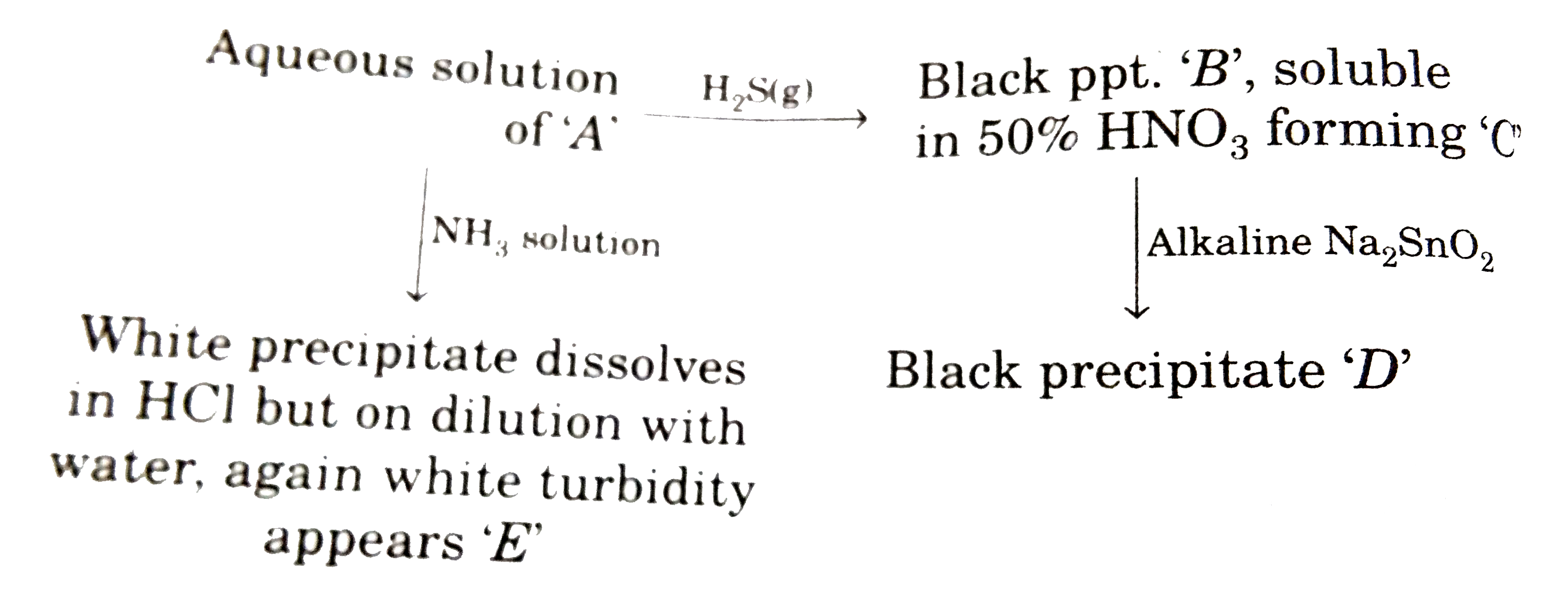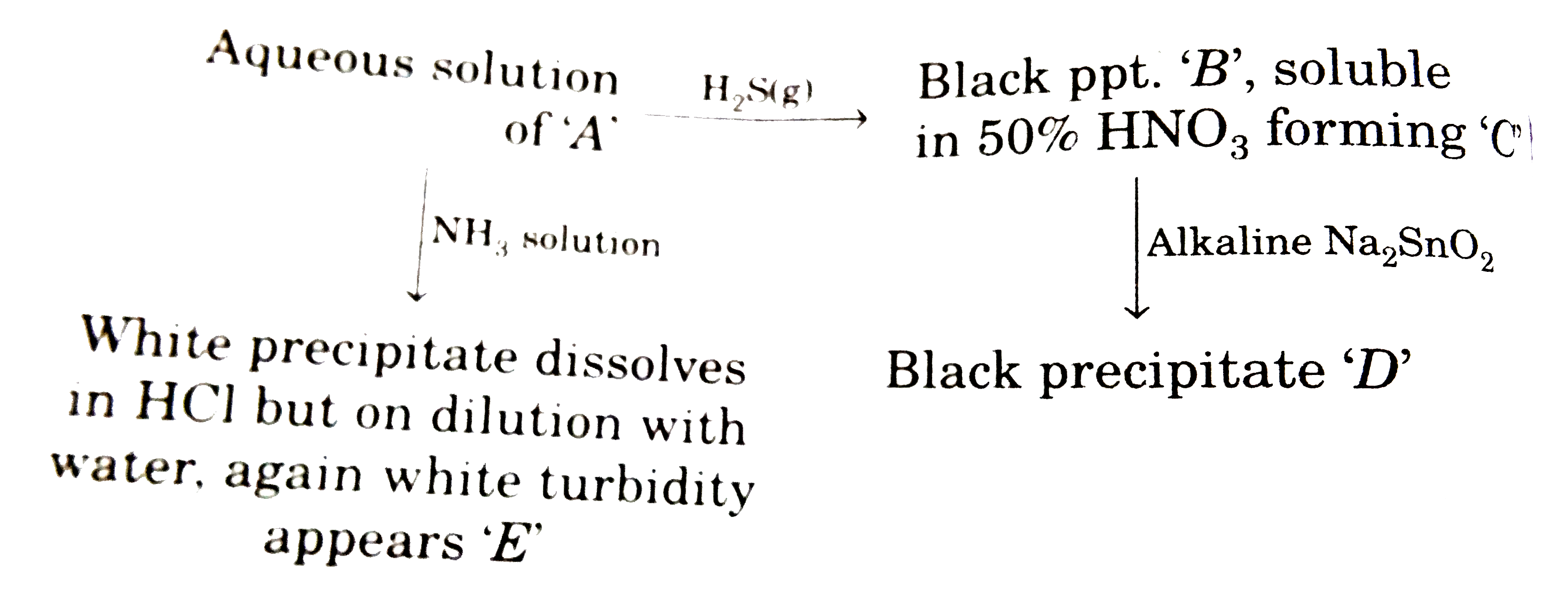
Moreover, the salt (A) on heating with solid K2Cr2O7 and concentrated H2SO4 produces deep red vapors which dissolve in sodium hydroxide solution forming a yellow solution. This yellow solution gives yellow precipitate with Ba(NO3)2 solution. On the basis of teh aforesaid characteristic informations answer the following questions:
Which of the following statements is incorrect?
The black precipitate D is of bismuth
The black precipitate D is of Hg+Hg(NH2)NO3
Aqueous solution of A gives yellow precipitate with freshly prepared 10% solution of pyrogallol.
Aqueous solution of A gives red precipitate with 8-hydroxyqunoline (5%) and potassium iodide (6M) in acidic medium.
The correct Answer is:D

(d) Bi3++C9H7ON+H++4I−→C9H7ON.HBiI4⏐↓ (Red ppt.)
(c) Bi3++C6H3(OH)3→Bi(C6H3O3)⏐⏐↓+3H+ (yellow ppt.)
Topper's Solved these Questions
- SALT ANALYSISBOOK - GRB PUBLICATIONCHAPTER - SALT ANALYSISEXERCISE - Comprehension 2
1 Videos
- SALT ANALYSISBOOK - GRB PUBLICATIONCHAPTER - SALT ANALYSISEXERCISE - Comprehension 3
1 Videos
- SALT ANALYSISBOOK - GRB PUBLICATIONCHAPTER - SALT ANALYSISEXERCISE - Comprehension 1
1 Videos
- S BLOCK ELEMENTSBOOK - GRB PUBLICATIONCHAPTER - S BLOCK ELEMENTSEXERCISE - SUBJECTIVE TYPE
9 Videos
- THERMODYNAMICSBOOK - GRB PUBLICATIONCHAPTER - THERMODYNAMICSEXERCISE - All Questions
704 Videos
Similar Questions
Knowledge Check

Moreover, the salt (A) on heating with solid K2Cr2O7 and concentrated H2SO4 produces deep red vapors which dissolve in sodium hydroxide solution forming a yellow solution. This yellow solution gives yellow precipitate with Ba(NO3)2 solution. On the basis of teh aforesaid characteristic informations answer the following questions:
Select the correct statement.AAqueous solution of A reacts with AgNO3 solution to give white precipitate which turns yellow on treatement with sodium arsenite.BAqueous solution of A produces white precipitate with sodium hydroxide which turns yellowish-white on boiling.CWhite turbidity E is soluble in dilute mineral acids.DAll of the above
Moreover, the salt (A) on heating with solid K2Cr2O7 and concentrated H2SO4 produces deep red vapors which dissolve in sodium hydroxide solution forming a yellow solution. This yellow solution gives yellow precipitate with Ba(NO3)2 solution. On the basis of teh aforesaid characteristic informations answer the following questions:
Acidified solution of A, on treatment with KI gives black precipitate F which dissolves in excess of reagent forming the coloured compound G. The chemical composition of F and G are respectively:AHgI2 and [HgI4]2−BPbI2 and [PbI4]2−CBiI3 and [BiI4]−DCu2I2 and CuI2
Moreover, the salt (A) on heating with solid K2Cr2O7 and concentrated H2SO4 produces deep red vapors which dissolve in sodium hydroxide solution forming a yellow solution. This yellow solution gives yellow precipitate with Ba(NO3)2 solution. On the basis of teh aforesaid characteristic informations answer the following questions:
The black precipitate F on heating with water produces:AHg(OH)2BBiOICBiO.OHDCuO.OH

Moreover, the salt 'A' on heating with solid K2Cr2O7 and concentrated H2SO4 produces deep red vapours which dissolve in sodium hydroxide solution forming a yellow solution. This yellow solution gives yellow precipitate with Ba((NO)3)2 solution.
On the basis of the aforesaid characteristic informations answer the following question :
Reaction involved in comprehension :
2Bi3+(A)+3H2SH+−−→Bi2S3⏐⏐↓(black)(B)+6H+
Bi2S3+8HNO3→2Bi(NO3)3(C)+2NO+3S+4H2O
Bi3++3OH−NaOH−−−→Bi(OH)3⏐⏐↓(white),2Bi(OH)3(white)+3[Sn(OH)4]2−→2Bi⏐⏐↓(D)+3[Sn(OH)6]2−
Bi3++3OH−Na4OH−−−−→Bi(OH)3⏐⏐ ⏐↓(white),Bi(OH)3daar(white)+3HCl→BiCl3+3H2O
BiCl3+H2O→BiOCl⏐↓(bismuth oxychloride)(E)+2HCl
4NaCl+K2Cr2O7+3H2SO4(conc.)→2CrO2Cl2(deep red vapours)+2Na2SO4+K2SO4+3H2O
CrO2Cl2+4OH−→CrO2−4+2Cl−+2H2O
CrO2−4+BaCrO4⏐⏐↓ (yellow)
Acidified solution of 'A' on treatment with Kl gives black precipitate 'F' which dissolves in excess of reagent forming the coloured compound 'G'.The chemical composition of 'F' and 'G' are respectively:
View Solution
Moreover, the salt 'A' on heating with solid K2Cr2O7 and concentrated H2SO4 produces deep red vapours which dissolve in sodium hydroxide solution forming a yellow solution. This yellow solution gives yellow precipitate with Ba((NO)3)2 solution.
On the basis of the aforesaid characteristic informations answer the following question :
Reaction involved in comprehension :
2Bi3+(A)+3H2SH+−−→Bi2S3⏐⏐↓(black)(B)+6H+
Bi2S3+8HNO3→2Bi(NO3)3(C)+2NO+3S+4H2O
Bi3++3OH−NaOH−−−→Bi(OH)3⏐⏐↓(white),2Bi(OH)3(white)+3[Sn(OH)4]2−→2Bi⏐⏐↓(D)+3[Sn(OH)6]2−
Bi3++3OH−Na4OH−−−−→Bi(OH)3⏐⏐ ⏐↓(white),Bi(OH)3daar(white)+3HCl→BiCl3+3H2O
BiCl3+H2O→BiOCl⏐↓(bismuth oxychloride)(E)+2HCl
4NaCl+K2Cr2O7+3H2SO4(conc.)→2CrO2Cl2(deep red vapours)+2Na2SO4+K2SO4+3H2O
CrO2Cl2+4OH−→CrO2−4+2Cl−+2H2O
CrO2−4+BaCrO4⏐⏐↓ (yellow)
Which of the following statements is incorrect ?
View Solution
Moreover, the salt 'A' on heating with solid K2Cr2O7 and concentrated H2SO4 produces deep red vapours which dissolve in sodium hydroxide solution forming a yellow solution. This yellow solution gives yellow precipitate with Ba((NO)3)2 solution.
On the basis of the aforesaid characteristic informations answer the following question :
Reaction involved in comprehension :
2Bi3+(A)+3H2SH+−−→Bi2S3⏐⏐↓(black)(B)+6H+
Bi2S3+8HNO3→2Bi(NO3)3(C)+2NO+3S+4H2O
Bi3++3OH−NaOH−−−→Bi(OH)3⏐⏐↓(white),2Bi(OH)3(white)+3[Sn(OH)4]2−→2Bi⏐⏐↓(D)+3[Sn(OH)6]2−
Bi3++3OH−Na4OH−−−−→Bi(OH)3⏐⏐ ⏐↓(white),Bi(OH)3daar(white)+3HCl→BiCl3+3H2O
BiCl3+H2O→BiOCl⏐↓(bismuth oxychloride)(E)+2HCl
4NaCl+K2Cr2O7+3H2SO4(conc.)→2CrO2Cl2(deep red vapours)+2Na2SO4+K2SO4+3H2O
CrO2Cl2+4OH−→CrO2−4+2Cl−+2H2O
CrO2−4+BaCrO4⏐⏐↓ (yellow)
The black precipitate 'F' on heating with water produces :
View SolutionWhich of the following compound(s) give yellow precipitate with BaCI2 solution?
View SolutionWhich of the following salt on heating with solid K2Cr2O7 and Conc. H2SO4 , orange red vapours are evolved which turn NaOH solution yellow.
View Solution
